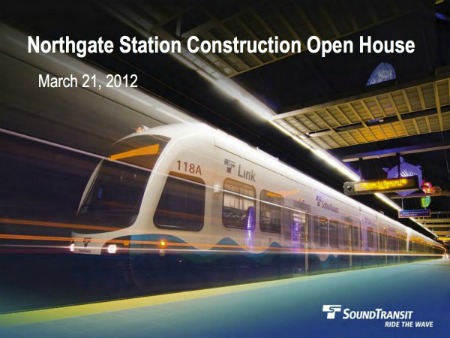Eight years before the planned opening of Northgate Station, it can be difficult to visualize the enormity of the construction project and how it will look in the end. But the following illustrated video from Sound Transit does a pretty good job of showing us what we’re in for.
Perhaps even more informative is the slideshow presented at last week’s open house, which explained many of the measures Sound Transit is taking to limit Maple Leaf’s exposure to construction issues.

So far, it appears the majority of the work will be near the portal exit at Northeast 94th Street and First Avenue Northeast, starting with overhead powerline work estimated in late 2013-2015 along First Avenue, from 94th to Northeast 107th Street.
First Avenue also will bear the brunt of the construction traffic, though plans are to otherwise try to keep trucks at a minimum in the neighborhood (view the truck route on slide 22 on the presentation.)
Although noise will be a bigger topic at the next open house, at this time we’re told there will be noise limits on the construction work from 10 p.m. to 7 a.m. weekdays, and from 10 p.m. to 9 a.m. weekends and holidays, and that daytime construction activities will comply with city’s construction noise limits. In addition, plans include
- A solid plywood construction screening wall 16 feet in height,
- Stationary equipment (compressors, generators) enclosed in noise reducing material
- Trucks – no beeping alarms at night
- Independent monitoring
Seattle Transit Blog had a nice writup on the meeting, including an update on the pedestrian bridge from North Seattle Community College to the light-rail station. Although it’s still an option to include in the project, with a price tag of $16 million to $20 million, it still has a long way to go. In the editorial, the Seattle Transit Blog suggested that Sound Transit choose the bridge over building an additional parking garage, which might be needed to replace the 117 stalls that the project will permanent displace. It writes:
Sound Transit is currently bound by the Federal Transit Administration to replace those 117 spaces. Sound Transit could seek an exemption from the FTA – with abundant private parking and the potential for Metro to re-purpose much of their Northgate-Downtown service to feed into the station, we don’t feel forging ahead with parking replacement is a good use of transit dollars.
Do you have a preference between additional parking spaces at the bridge? Any other observations from the meeting or the presentation?


I’m with the folks above on no bridge, it isn’t worth the expense. If people don’t want to spend the extra 5 minutes to walk to the 92nd overpass as commuters currently do, the 75 runs from the Transit Center up and across it to the community college and on to Ballard. That need is already being met by the current Metro bus route. Save that 16 Million or spend part of it on making sidewalk improvements, we don’t need the bridge.
They also have higher densities in Europe and parts of Asia, making it feasible to walk to work, markets, etc. I would love to see the reaction of people in the neighborhood if we made it more walk-able (ie increased residential and business density). People want it all walk-ability and a quiet family neighborhood. With few jobs in the immediate (ie walkable) area, you aren’t going to get much investment in pedestrian amenities.
Of course, more sidewalks would be nice…but there are few places to walk to in Maple Leaf, not too mention lower density compred to other parts of the city.
@Frank:
“Spend money on improving side walks and make people walk a little longer like they do in Europe”
Well said! I think having some people walk more would be a win-win situation. I have family in both Asia and Europe who walk a lot between bus stops, train stations, work, and shops. There is direct relation to their health and weight compared to many of the people here in the “Big” ‘Ol US of A.
Do we really need to spend 16 million on bridge to the rail station when there is an overpass on 92nd street? Spend money on improving side walks and make people walk a little longer like they do in Europe.
Nowhere do I find pedestrian improvements. We desperately need sidewalks between 5th NE and Roosevelt Way NE from at least NE 100th to NE 105th. If no bridge is built, all foot traffic comes from the east of this station. We need east/west access from 15th NE to 1st NE for cars, for bikes, for pedestrians. Where are the plans for these amenities? The logical street for east west access is NE 103rd, which extends from 15th to 1st. Presently NE 105th Street, a ONE LANE TWO WAY road, with a sheer drop into Thornton Creek is the default access point. It makes no sense.
Getting a bus to Northgate from the east is next to impossible so most people drive their car there and park in the park n’ ride. Unless they plan to add some more direct routes to feed into the station, they better replace the parking lost. The park n’ ride already fills up even without the new station.
That IS a pretty huge project; I wasn’t sure what “Northgate Station” meant until seeing it.
Too bad they couldn’t keep it underground until the station; elevated tracks make the area below dingy and dark. New York City removed its elevated system for that very reason.
I guess the counter argument (other than cost) is that this way it will be clearly visible from the freeway and will serve as a good advertisement, whereas if it were below ground it would be “out of sight out of mind”.